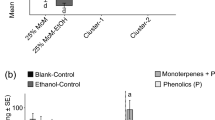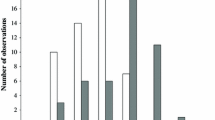Abstract
Host plant chemistry can play an important role in determining the evolution of host use patterns in herbivorous insects by influencing host selection, consumption, and assimilation of foliage. We used a comparative approach to test the hypothesis that specialist herbivores of sweetbay magnolia (Magnolia virginiana) possess adaptations that allow them to overcome chemical deterrents or toxins that prevent herbivory by unadapted herbivores. The three silkmoth species in the genusCallosamia can be collectively regarded as specialists on magnoliaceous hosts; however, only the monophagousC. securifera is able to complete development on sweetbay magnolia, its natural host. In laboratory assays with intact foliage, bothC. angulifera and the polyphagousC. promethea fed readily on sweetbay but were unable to survive past the third instar. Two neolignan compounds, magnolol and a biphenyl ether, were found to reduce neonate growth and survival of unadapted herbivore species when painted on acceptable host leaves at concentrations similar to those found in sweetbay foliage. Both compounds significantly reduced neonate growth ofC. angulifera andC. promethea but had no effect on the sweetbay specialist,C. securifera, indicating that the latter species possesses the unique ability in the genus to tolerate, metabolize, or otherwise circumvent the phytochemical defenses of this host.
Similar content being viewed by others
References
Barbosa, P. 1988. Some thoughts on “the evolution of host range.”Ecology 69:912–915.
Barbosa, P., Gross, P., Provan, G. J., Pacheco, D. Y., andStermitz, F. R. 1990. Allelochemicals in foliage of unfavored tree hosts of the gypsy moth,Lymantria dispar L. 1. Alkaloids and other components ofLiriodendron tulipifera L. (Magnoliaceae),Acer rubrum L. (Aceraceae), andCornus florida L. (Cornaceae).J. Chem. Ecol. 16:1719–1730.
Benson, W. W., Brown, K. S., andGilbert, L. E. 1975. Coevolution of plants and herbivores: Passion flower butterflies.Evolution 29:659–680.
Berenbaum, M. 1978. Toxicity of a furanocoumarin to armyworms: A case for biosynthetic escape from insect herbivores.Science 201:532–534.
Berenbaum, M. 1981. Furanocoumarin distribution and insect herbivory in Umbelliferae: Plant chemistry and community structure.Ecology 62:1254–1266.
Berenbaum, M., Zangerl, A. R., andNitao, J. K. 1986. Constraints on chemical coevolution: Wild parsnips and the parsnip webworm.Evolution 40:1215–1228.
Berenbaum, M., Zangerl, A. R., andLee, K. 1991. Chemical barriers to adaptation by a specialist herbivore.Oecologia 80:501–506.
Bernard, C. B., Arnason, J. T., Philogène, B. J. R., Lam, J. andWaddell, T. 1989. Effect of lignans and other secondary metabolites of the Asteraceae on the monooxygenase activity of the European corn borer.Phytochemistry 28(5):1373–1377.
Bernays, E. A., andChapman, R. F., 1987. The evolution of deterrent responses in plant-feeding insects, pp. 159–173,in R. F. Chapman, E. A. Bernays, and J. G. Stoffolano, Jr. (eds.). Perspectives in Chemoreception and Behavior. Springer-Verlag, New York.
Bernays, E. A., andGraham, M. 1988. On the evolution of host specificity in phytophagous arthropods.Ecology 69(4):886–892.
Blau, P. A., andFeeny, P. 1978. Allylglucosinolate and herbivorous caterpillars: A contrast in toxicity and tolerance.Science 200:1296–1298.
Bowers, D. M. 1988. Chemistry and coevolution: Iridoid glycosides. plants, and herbivorous insects, pp. 133–165,in K. C. Spencer (ed.). Chemical Medication of Coevolution Academic Press, New York.
Brown, L. N. 1972. Mating behavior and life habits of the sweet-bay silk moth (Callosamia carolina).Science 176:73–75.
Clark, A. M., El-Feraly, F. S., andLi, W. 1981. Antimicrobial activity of phenolic constituents ofMagnolia grandiflora L.J. Pharm. Sci. 70(8):951–952.
Doskotch, R. W., andFlom, M. S. 1972. Acuminatin, a newbis-phenylpropide fromMagnolia acuminata L.Tetrahedron 28:4711–4717.
Ehrlich, P. R. andRaven, P. H. 1964. Butterflies and plants: A study in coevolution.Evolution 18:586–608.
El-Feraly, F. S., andYee-Ming, C. 1978. Isolation and characterization of the sesquiterpene lactones costunolide, parthenolide, costunolide diepoxide, santamarine, and reynosin fromMagnolia grandiflora L.J. Pharm. Sci. 67:347–350.
Erickson, J. M., andFeeny, P. 1974. Sinigrin: a chemical barrier to the black swallowtail butterfly,Papilio polyxenes.Ecology 55:103–111.
Farrell, B., andMitter, C. 1990. Phylogenesis of insect/plant interactions: HavePhyllobrotica leaf beetles (Chrysomelidae) and the Lamiales diversified in parallel?Evolution 44:1389–1404.
Faure, M., Lissi, E., Torres, R., andVidela, L. 1990. Antioxidant activities of lignans and flavonoids.Phytochemistry 29(12):3773–3775.
Feeny, P. P. 1991. Chemical constraints on the evolution of swallowtail butterflies. pp. 315–340,in P. W. Price, T. M. Lewinsohn, G. W. Fernandes, and W. W. Benson (eds.). Plant-Animal Interactions: Evolutionary Ecology in Tropical and Temperate Regions. Wiley, New York.
Feeny, P. P., Rosenberry, L., andCarter, M. 1983. Chemical aspects of oviposition behavior in butterflies, pp. 27–76,in S. Ahmad (ed.). Herbivorous Insects: Host-Seeking Behavior and Machanisms. Academic Press, New York.
Ferguson, D. C. 1972. Bombycoidea, Saturniidae (in part).In R. B. Dominick, (ed.). The Moths of America North of Mexico. Fasc. 20.2B. Classey, London.
Fraenkel, G. 1959. The raison d'etre of secondary plant substances.Science 129:1466–1470.
Futuyma, D. J., andMcCafferty, S. S. 1990. Phylogeny and the evolution of host plant associations in the leaf beetle genusOphraella (Coleoptera, Chrysomelidae).Evolution 44:1885–1913.
Johnson, K. S., Snider, D., andScriber, J. M. 1996. Estimates of genetic differentiation amongCallosamia species andHyalophora cecropia (Saturniidae) using allozyme electrophoresis.J. Lepid. Soc. 50:217–225.
Lawton, J. H., andMcNeill, S. 1979. Between the devil and the deep blue sea: On the problem of being a herbivore.Symp. Br. Ecol. Soc. 20:223–244.
Lindroth, R. L., Scriber, J. M., andHsia, M. T. S. 1986. Differential responses of tiger swallowtail subspecies to secondary metabolites from tulip tree and quaking aspen.Oecologia 70:13–19.
Lindroth, R. L., Scriber, J. M., andHsia, M. T. S. 1988. Chemical ecology of the tiger swallowtail: Mediation of host use by phenolic glycosides.Ecology 69:814–822.
MacRae, W. D., andTowers, G. H. N. 1984. Biological activity of lignans.Phytochemistry 23:1207–1226.
Miller, J. S. 1987. Host-plant relationships in the Papilionidae (Lepidoptera): Parallel cladogenesis or colonization?Cladistics 3:105–120.
Mitter, C., andBrooks, D. R. 1983. Phylogenetic aspects of coevolution, pp. 65–98,in D. J. Futuyma and M. Slatkin (eds.). Coevolution. Sinauer Press, Sunderland, Massachusetts.
Nitao, J. K., 1995. Evolutionary stability of swallowtail adaptations to plant toxins, pp. 39–52,in J. M. Scriber, Y. Tsubaki, and R. C. Lederhouse (eds.). Swallowtail Butterflies: Their Ecology and Evolution. Scientific Publishers, Washington, D.C.
Nitao, J. K., Nair, M. G., Thorogood, D. L., Johnson, K. S., andScriber, J. M. 1991. Bioactive neolignans from the leaves ofMagnolia virginiana.Phytochemistry 30(7):2193–2195.
Nitao, J. K., Johnson, K. S., Scriber, J. M., andNair, M. G. 1992.Magnolia virginiana neolignan compounds as chemical barriers to swallowtail butterfly host use.J. Chem. Ecol. 18(9):1661–1671.
Peigler, R. S. 1976. Observations on host plant relationships and larval nutrition inCallosamia (Saturniidae).J. Lepid. Soc. 30:184–187.
Price, P. W., Bouton, C. E., Gross, P., McPherson, B. A., Thompson, J. N., andWeiss, A. E. 1980. Interactions among three trophic levels: influence of plants on interactions between insect herbivores and natural enemies.Ann. Rev. Ecol. Syst. 11:41–65.
Price, P. W., Westoby, M., Rice, B., Atsatt, P. R., Fritz, B. S., Thompson, J. N., andMobly, K. 1986. Parasite mediation in ecological interactions.Ann. Rev. Ecol. Syst. 17:487–505.
Rao, K. V., andDavis, T. L. 1982. Constituents ofMagnolia grandiflora. III. Toxic principle of the wood.J. Nat. Prod. 45:283–287.
Rao, K. V., andJuneau, R. J. 1975. Glycosides ofMagnolia. III. Structural elucidation of magnolidin.Lloydia (J. Nat. Prod.) 38:339–342.
Rausher, M. 1988. Is Coevolution dead?Ecology 69(4):898–901.
Scriber, J. M. 1988. Tale of the tiger: Beringial biogeography, binomial classification, and breakfast choices in the Papilio glaucus complex of butterflies, pp. 241–301,in K. C. Spencer (ed.). Chemical Mediation of Coevolution. Academic Press. New York.
Scriber, J. M., andLederhouse, R. C. 1992. The thermal environment as a resource dictating geographic patterns of feeding specialization of insect herbivores, pp. 429–466,in M. R. Hunter, R. Ohgushi, and P. W. Price (eds.). Effects of Resource Distribution on Animal-Plant Interactions. Academic Press, New York.
Scriber, J. M., Lindroth, R. L., andNitao, J. 1989. Differential toxicity of a phenolic glycoside from quaking aspen toPapilio glaucus butterfly subspecies, hybrids and backcrosses.Oecologia 81:186–191.
Spencer, K. C. 1988. Chemical mediation of coevolution in thePassiflora-Heliconius interaction. pp. 167–240,in K. C. Spencer (ed.). Chemical Mediation of Coevolution. Academic Press, New York.
Stone, S. E. 1991. Foodplants of world Saturniidae. p. 13.Lepid. Soc. Mem. 4:000.
Thompson, J. N. 1988. Coevolution and alternative hypotheses on insect/plant interactions.Ecology 69(4):893–895.
Author information
Authors and Affiliations
Rights and permissions
About this article
Cite this article
Johnson, K.S., Scriber, J.M. & Nair, M. Phenylpropenoid phenolics in sweetbay magnolia as chemical determinants of host use in saturniid silkmoths (Callosamia). J Chem Ecol 22, 1955–1969 (1996). https://doi.org/10.1007/BF02040088
Received:
Accepted:
Issue Date:
DOI: https://doi.org/10.1007/BF02040088




